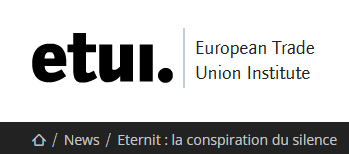

Asbestos is a family of mineral fibres occurring naturally in certain rocks. It was widely exploited and used throughout the world due to its particularly interesting properties. Inexpensive and non-flammable, it is resistant to pressure, friction, humidity and chemicals. Its main use was in the construction and building industry, in particular as asbestos cement. It is still to be found in corrugated sheets, roofing, gutters, drains and heating ducts.
The manufacturing process of asbestos cement was patented in 1900 by Austrian chemist Ludwig Hatschek under the name of Eternit, from the Latin aeternus meaning eternal or immortal. The patent was subsequently sold to several building material manufacturers, most of which would take the name Eternit. In 1929, the European Eternit companies merged into an association, the Sociétés Associées d'Industries Amiante-Ciment. Three large families were to dominate these companies throughout the 20th century: the Cuveliers in France, the Schmidheinys in Switzerland, and the Emsens in Belgium.
In the 1960s and 1970s, Belgium progressively became the largest per capita consumer of asbestos, with Eternit Belgium headed by Louis de Cartier de Marchienne, married to the descendant of the Emsens family. A wealthy businessman with a long aristocratic lineage, the Belgian baron was linked to some of the country's most powerful industrial families. Heading several of the group's entities from the end of the 1960s to the mid-1980s, he quickly became a leading figure of the asbestos empire. The end of his reign was to mark the beginning of his legal troubles.
What makes asbestos dangerous is its fibrous nature and the tiny size of its fibres. When inhaled, they penetrate deeply into the lungs, with the potential to cause lung, ovarian and laryngeal cancers. These cancers often develop decades after exposure. Asbestos is also responsible for asbestosis, an irreversible and incurable disease causing severe respiratory difficulties and leading to death in the relatively short term. And yet, asbestos was long considered an ideal material. Called the “mineral of the twentieth century”, asbestos was widely used until the 1980s, despite its toxic potential being revealed much earlier.
The first proven case of asbestosis was diagnosed in 1900 by a London doctor. The patient was a young asbestos worker whose lung tissue was completely destroyed by asbestos fibres. Scientific data started to build up on the harmfulness of asbestos, but without any impact on industrialists and monitoring organisations. But insurance companies were interested. In 1918, an American insurer refused to insure asbestos workers for the first time. In Europe, it would take decades for asbestosis to be recognised as an occupational disease, and even longer for it to be definitively banned. And for good reason: for a long time, the danger stemming from the fibres trapped in cement was denied by Eternit and the other major asbestos producers, who lobbied hard to delay the ban as long as possible, while agreeing to compensate victims to avoid litigation.
In 2011, the Belgian courts sentenced Eternit for the first time, forcing the company to compensate the family of an environmental victim of asbestos to the tune of 250,000 euros. The court found that Eternit was at fault in continuing to use asbestos and in playing down its dangers despite them being known. “It is sufficiently proven that Eternit has taken a personal interest in the way it has tried to play down and cover up the dangers of asbestos and in the fact that it has fought legal initiatives to protect public health.” The court also took account of the “incredible cynicism with which scientific knowledge was swept aside for the sake of profit”.
One year later, a Turin court took an interest in Eternit. After five years of investigation and a three-year trial, Louis de Cartier de Marchienne and Stephan Schmidheiny were found responsible for the death of some 3,000 people in Italy, former workers or inhabitants of four places where Eternit-Italy had its factories. The Italian court sentenced the two asbestos leaders to 16 years in prison and to pay tens of millions of euros to civil parties for “permanent intentional environmental disaster” and “voluntary neglect of safety measures”. The Belgian baron would die before his appeal was heard. Stephan Schmidheiny ended up having his prison sentence increased to 18 years. But after five years of legal proceedings, the Court of Cassation finally acquitted Schmidheiny, considering that he benefited from the statute of limitations. In a subsequent criminal trial, this time before the Naples Assizes, Stephan Schmidheiny was sentenced on 6 April 2022 to three and a half years in prison for manslaughter.
For its part, Eternit has always maintained that no fault could be attributed to it, arguing that the dangers of asbestos were not clearly determined at the time of the events. It is difficult to imagine that Eternit was not aware of the seriousness of the health risks from the beginning. As proof, the internal notes of an American industrialist following the remarkable communication of pneumologist Irving Selikoff in the 1960s were cited: “Our biggest worry right now is to find a way to prevent Selikoff from creating problems and influencing our sales.” At the same time in France, the famous pneumologist Jude Turiaf, who was considering a more in-depth study of the origin of pleural cancer in an affected worker, was rejected by the Chambre syndicale des producteurs d'amiante. These elements, far from being isolated facts, underline the true conspiracy of silence orchestrated by the asbestos industry, including Eternit.
To this day, asbestos continues to kill 200,000 people a year throughout the world. In Belgium, ABEVA provides assistance to victims of asbestos, both in terms of administrative procedures and the creation of a space for sharing and solidarity.